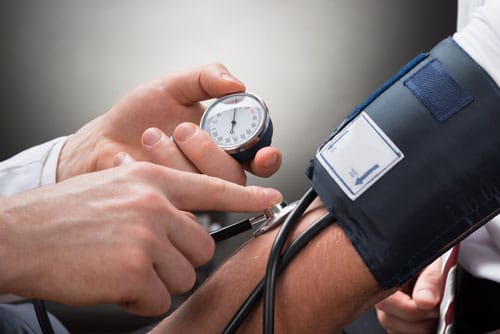The American Heart Association’s new blood pressure guidelines were supposedly put in place to save lives. A new report shows they may actually cost lives.
In late 2017, the AHA decided that people with blood pressure higher than 130/80 should take drugs to lower it. The previous threshold was 140/80.
Researchers from the University of Sydney and Bond University in Australia examined the real-life impact of the new lowered guidelines.
They published their scathing report in the prestigious Journal of the American Medical Association, Internal Medicine.
31 Million Americans at Risk
The report points out that the new 130/80 guidelines will cause an additional 31 million Americans to be labeled as having high blood pressure. The study concludes:1
- 80% of these people would get no benefit in terms of heart disease risk reduction by taking drugs to lower their blood pressure.
- 11% would get a marginal benefit
- Only 9% would get a major benefit.
Even more disturbing, the new guidelines put people’s lives at risk in three ways, the study states:2
- Anxiety. Millions of Americans will be labeled unwell, despite having little, if any, risk of heart disease. “Labeling a person as having hypertension increases their risk of anxiety and depression,” said Dr. Katy Bell. She’s an epidemiologist at the University of Sydney’s School of Public Health. And she’s the study’s lead author.
- Side effects. Study after study has found that blood pressure medications have a wide range of side effects. Many of them are severe. They include kidney damage, sexual problems, chronic cough, fatigue, and weight gain.3
- Loss of health insurance. The guidelines instantly give 31 million Americans a “pre-existing condition.” This means they may have a hard time getting insurance or will have to pay more for it.
Big Pharma Wins Big
Several respected medical groups oppose the new guidelines. The American College of Physicians states that the lower threshold is “not supported by evidence.”
The Academy of Family Physicians says that before the guidelines were put in place, the “harms of treating a patient to a lower blood pressure were not assessed.”4
So if there’s so much evidence that the hypertension edict harms instead of helps patients, why did the American Heart Association issue the guidelines?
One clue may be its funding. In fiscal year 2016-17, the AHA got nearly $15 million in donations from Big Pharma. And, of course, with so many people newly diagnosed with hypertension, Big Pharma stands see massive profit increases from blood pressure drug sales.5 6
Do You Really Have High Blood Pressure?
There are many natural ways to lower your blood pressure, which we’ve told you about in the past. But before you worry about lowering your blood pressure, first make sure that it is, in fact, high.
A recent study found that 20% of patients who’ve been diagnosed with high blood pressure actually don’t have it. Their doctors were using outdated equipment or they were using incorrect procedures to take readings.
Here is a simple checklist to help ensure you get an accurate reading:7
- Do: Empty your bladder before your blood pressure is taken.
- Do: Sit in a chair, feet flat on the ground, legs uncrossed, with your back supported and without talking. Sit quietly for at least five minutes and preferably 12 minutes before you get your blood pressure measured.
- Do: Roll up your sleeve so the blood pressure cuff rests on bare skin, not clothing.
- Don’t: Exercise, consume caffeine, or smoke within 30 minutes of your test.
- Don’t: Sit or lie on the exam table. That can result in a falsely low reading.
- Don’t: Let your arm dangle or rest in your lap during the reading. It should be supported on a surface such as a desk or chair arm.
And make sure that your doctor’s office is using up-to-date equipment to measure your blood pressure.
Researchers recommend automated digital devices over the old-fashion blood pressure sphygmomanometers. (Those are the ones with the pumping bulb and circular dial.) The automatic devices are more expensive—and more accurate.
And always ask for your blood pressure to be taken three times. This provides better accuracy.
Editor’s Note: First, they said he’d go to prison. Then they threatened his children. But that didn’t stop this brave whistleblower from exposing the FDA’s darkest secret… And the 373 natural disease cures and treatments they NEVER wanted you to see.
GO HERE to find out exactly what he revealed.
Like this Article? Forward this article here or Share on Facebook.
References:
1 https://medicalxpress.com/news/2018-04-blood-pressure-guidelines-experts.html
2 https://sydney.edu.au/news-opinion/news/2018/04/17/blood-pressure—new-guidelines-could-put-lives-at-risk.html
3 https://medlineplus.gov/ency/article/007484.htm
4 https://jamanetwork.com/journals/jamainternalmedicine/article-abstract/2678449?redirect=true
5 http://www.heart.org/idc/groups/heart-public/@wcm/@fin/documents/downloadable/ucm_498589.pdf
6 https://www.naturalnews.com/2017-11-28-big-pharma-profits-thanks-to-new-aha-guidelines-now-half-of-all-americans-have-high-blood-pressure.html
7 https://www.institutefornaturalhealing.com/2017/11/your-doctor-is-taking-your-blood-pressure-all-wrong/

